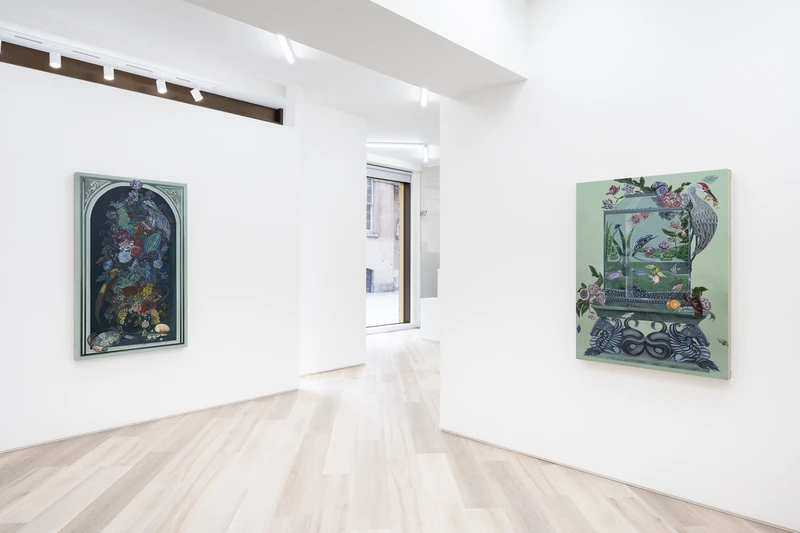Sabrina Bockler: Menagerie
13 May-10 Jun 2023
PV 13 May 2023, 1-4pm


Exhibition text by Maria Brito, Art Advisor, Author & Curator:
Back in the days of Middle French, ménagerie meant “the management of a household or farm” or “a place where animals are tended.” When English speakers adopted the term in the 1600s, they applied it specifically to places where wild and often foreign animals were kept and trained for exhibition. This second meaning was eventually generalized to refer to any varied mixture, especially one that includes things that are strange or foreign to one’s experience.
These varied definitions merge seamlessly and chaotically in Sabrina Bockler’s body of work for her first solo show at BEERS Gallery in London. “I am intrigued by the concept of domestic identity within the context of traditionally feminine labor and its role throughout history,” she writes, adding that her interests lie “in the tension between the traditional and the uncanny.”
When we see something familiar in a strange setting, we can’t help but become curious and inquisitive. We also feel a good deal of sensations that evoke both the idea of knowing something as well as that of novelty and surprise. By mixing disparate elements, Bockler creates copious still lifes that keep our eyes affixed on the canvas and our minds puzzled and amused at the same time.
Domestic identity refers to the way that individuals define themselves and their roles within the context of the home and family, and it is often closely linked to traditionally feminine labor such as cooking, cleaning, and caring for children. Throughout history, women have been largely responsible for these tasks, and as a result, domestic identity has been a significant part of women’s lives.
Women artists of the 15th century were often confined to painting still lifes for a variety of reasons related to societal norms and gender roles. It was considered a minor genre and often viewed as a simple and decorative form of art, rather than a serious pursuit. It didn’t require access to live models and could be created in the home using readily available materials.
For more than 400 years, female painters from Fede Galizia in the early 1600s to Georgia O’Keeffe from the 1900s have played a significant role in the development of still-life painting. But it was in the 18th and 19th centuries when the genre became a popular subject for women artists, particularly those who were confined to the domestic sphere due to societal expectations.
Dutch still-life paintings of the Golden Age often depicted rich and elaborate table settings filled with an abundance of objects, such as flowers, expensive glassware, silverware, tropical fruits, shells, and even live animals such as monkeys or parrots. In the sumptuous “A la Carte,” Bockler celebrates the genre and era with her own visual vocabulary and suggestive storytelling: sensuality, desire, femininity, and fertility are represented through aphrodisiac foods, such as pomegranates, figs, grapes, and oysters. The lobster, red and prominent, was the Surrealists’ symbol of eroticism and sexual excess, and it’s placed next to the peacock whose vivid colors and intricate patterns are related to pride, luxury, and refinement.
Bockler not only pays homage to the acclaimed 17th-century Dutch rococo artist Rachel Ruysch, whose flower paintings were known for their exquisite beauty and precision but adds her own sense of humor by incorporating several elements in her canvases: her own show dogs, a black cat whose bright eyes spy us from under a table and a couple of mischievous drunk monkeys, animals associated with human folly and the sins of pride and vanity.
The surreal and the traditional, the unsettling and the comforting coexist in Bockler’s world of rich and warm tones and painstaking details while reminding us that issues of gender and identity coupled with societal norms have shaped our views and behaviors for many centuries. In Bockler’s own words, her practice is a way to “reclaim the narrative of women’s contributions to the field of art and to encourage a reexamination of traditional gender assumptions surrounding labor and its division.”